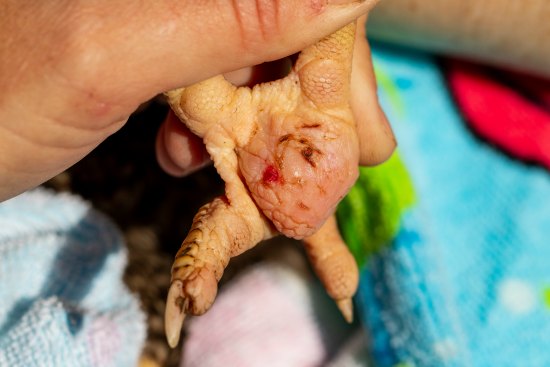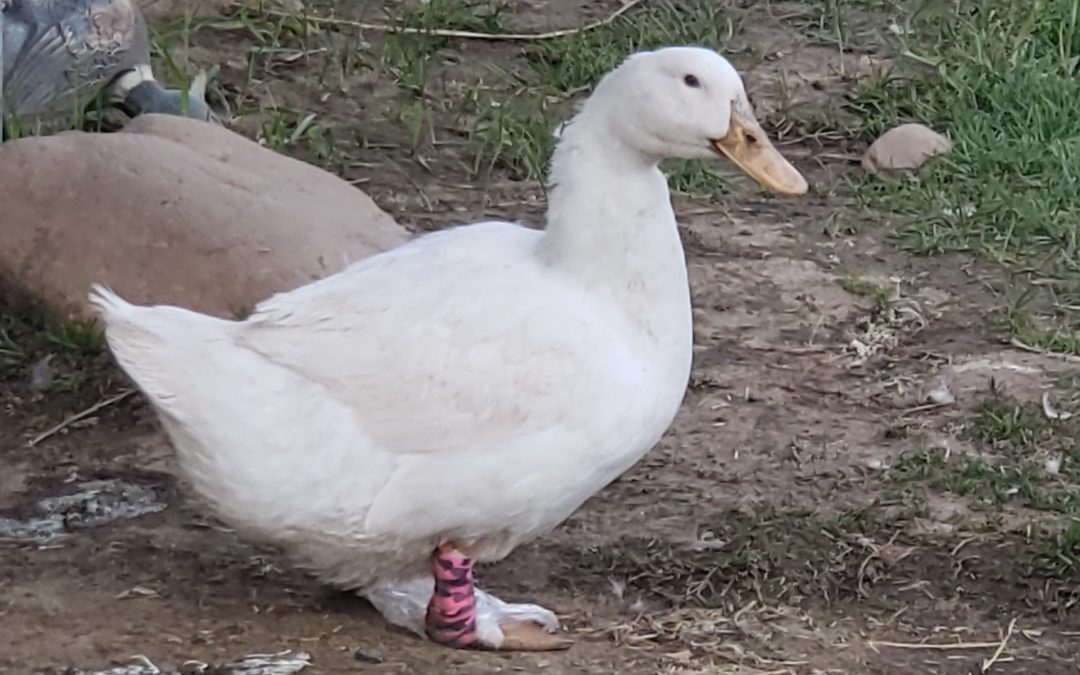Anyone who has had chickens or ducks for any extended amount of time has probably heard of bumblefoot. I just had an experience with one of our ducks and hopefully, this will help those of you just learning about bird healthcare.
If you have a duck or a chicken with bumblefoot, the first thing to do is relax, and realize it is really common. Most of your birds (if not every single one) will likely get bumblefoot at some point. It’s OK! It doesn’t require you to lose your mind over it, although, I almost did, in all honesty. I love my ducks, so it was very worrisome, but just know its most likely going to be OK. If it’s a new experience, you are likely to be a little confused. This isn’t just a duck or chicken problem either. Turkeys, guinea pigs (I was surprised too!) and geese can be susceptible to this ailment.
WHAT IS IT?

Bumblefoot effects many types of flocks. Image of a chicken with bumblefoot.
Bumblefoot is a common condition that effects many types of birds including chickens and ducks. This ailment is basically a staph infection in which bacteria enter the bird’s foot through a cut caused by a splinter or other sharp object. Those bacteria cause an infection that can travel up the leg. If the infection travels up the leg, prepare for surgery or the loss of your bird.
In my case, our duck Peaches had a scab near her claw that had spread upward along her toe. So after some reading and research, I made a trip to the Dollar Store for a quick “duck first aid kit.”
HOW TO TREAT BUMBLEFOOT
Once you locate the black scab that caused the problem, it’s usually right on the lump causing the bird to limp, you will need to soak the duck’s foot in Epsom salts. I never really measured it out, but we put tepid water in a bucket and let the duck just stand in the Epsom salt bath. The first few times, I had my son hold the duck and I dipped her foot in a Tupperware dish. Either works, but the bucket is a heck of a lot easier! This process loosens the scab. I did this three times before I felt the scab was loose enough for me to pull it out. WEAR GLOVES WHEN YOU DO THIS! Bumblefoot is a staph infection and the last thing you want is to spread it to yourself!!
Peaches wasn’t acting lethargic and she was still foraging, swimming, and eating, so I didn’t think it was necessary to force the scab out after the first Epsom salt soak, but I did watch it. After each foot soak, we used antimicrobial poultry spray. Once the scab felt loose, I pulled the nasty thing off and a long core of white and pink goo came out. The swelling did not decrease except around her toe. I used a few sprays of the anti-microbial spray and some Neosporin and wrapped her foot up in some gauze, a plastic baggie, and then some vet wrap. The plastic bag helped a little to keep water from washing off the Neosporin and poultry spray. We put the flock to bed, and even though her infection never spread, and we didn’t ever cut into her foot, I wanted to look into why she still had swelling. So I Googled some more…
*This video was taken before we removed the scab. This process worked but only for a day or two.
What concerned me the most, was when I began an internet search titled “why is my duck’s toe swollen.” One of the first articles I came across at this point suggested “natural remedies” don’t work and I should do surgery on my bird. I was stunned! I am barely capable of pulling out a splinter from my son’s hand, let alone conducting surgery on a webbed foot! Because I was still confused, I ended up calling a vet. Actually, I called 6 vets until one, an hour and a half drive away, agreed to see the duck. So we loaded up Peaches and took her to see a bird vet.
What I learned from the vet, saved my sanity, and was, therefore, worth the money and time it took to get her there. The vet assured me I had done the right thing, and that the duck’s infection was localized and not spreading, so it was crazy to slice her open. Instead, to give me some peace of mind, we got some anti-biotics and ant-inflammatory medication to administer twice a day. It seems like a lot of work, but it beats backyard surgery and stress, in my opinion. After visiting the vet, we did figure out how to spot bumblefoot early and treat it, as you can see below with our white Pekin, Giggles:
*Sadly, Giggles broke her claw on my son’s jeans while I was wrapping her foot up, BUT, we treated it with her bumblefoot and it healed in a few days. This was incredibly successful!
Giving a duck medication isn’t fun, and Peaches still has a small amount of swelling that’s likely permanent. Sometimes, the vet said this will happen. She’ll still live a long and happy life with a swollen toe. Here is how to orally medicate a duck:
I got lucky and neither of my ducks needed surgery, however, sometimes this is unavoidable. If the infection begins to spread up the leg, or the duck is not acting normal, backyard surgery can be the only solution to save your bird’s life. Since I didn’t have to do this, I don’t have any first-hand experience, but this article from Fresh Eggs Daily is a great resource.
There is one important thing to remember if you do decide surgery is needed. DO NOT use any pain killer or pain reliever on a bird or administer anything orally. There is a better chance of killing the bird with the pain reliever, especially any product that ends in ‘cane’ or ‘caine.’ These medications are toxic to poultry.
But, another important thing to remember is that bumblefoot happens! It’s very common and I should have been better prepared. Lesson learned. I have first aid kits all over the house, but I didn’t have any vet wrap, Epsom salts, or anti-microbial spray. Now, I have a complete duck first aid kit with all the tools needed should I ever have to perform backyard surgery.
*I did my best with these videos. We are new to making them, but I really hope they help anyone who loves their ducks as much as we do. Our kids often take the footage for these. I tried my best to explain, but please know that if you are emotionally attached to your animals, any ailment can be difficult, especially when it’s a new “problem.” This was a three-week learning experience for me, and I understand it can be stressful. Just trust your gut, and love your animals, and it will all end up ok!
This article was originally published at Ready Nutrition™ on June 17th, 2020







